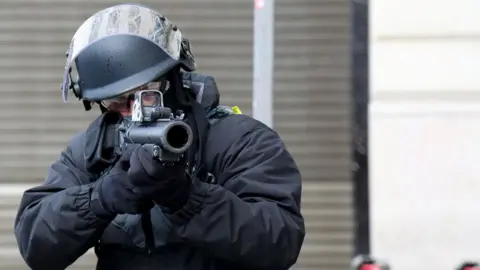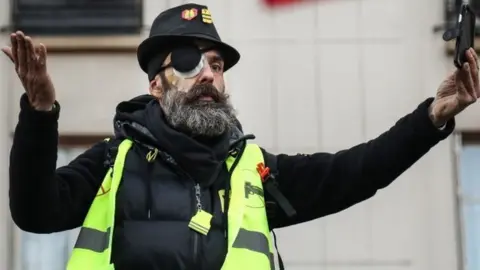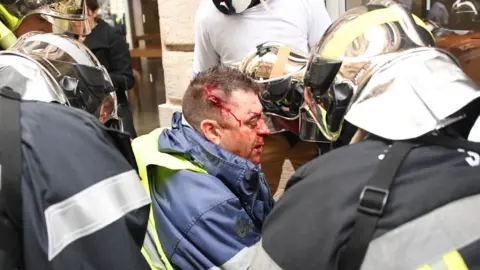Yellow-vest protests: French demonstrators condemn police violence
France's "yellow-vest" protesters are staging another round of demonstrations against the cost of living and President Emmanuel Macron's policies.
This week they are focusing on the police's use of rubber bullets.
Dozens of people have been injured since the weekly protests started in November. Several have lost eyes.
A leading figure in the movement, Jérôme Rodrigues, addressed the crowd a week after suffering a serious eye injury during a protest in Paris.
"They shoot at the population with a weapon of war," he said. "Is that what France is like today? We just want to fill the fridge and we end up losing an eye."
Much of the protesters' anger has been directed at the use of anti-riot LBD launchers - also known as "flash-balls". Officials have admitted that these were fired near the site where Mr Rodrigues was hit, but said the link with his injury was not clear.
 AFP
AFPA French court ruled on Friday that police could continue using the guns because of the threat of violence.
Peaceful rallies have sometimes ended in vandalism and 1,000 police officers have been among those wounded. At least 10 deaths have been linked to the unrest.
What is the latest?
Thousands of people are taking part in Saturday's round of marches in towns and cities across France.
A Facebook page set up by the organisers said they wanted to an end to the government's "disproportionate use of force designed to silence the protesters".
 AFP
AFPAt a "great march of the wounded" in Paris, healthy protesters wore eye patches in solidarity.
Mr Rodrigues, a 39-year-old former salesman who is training to become a plumber, told the BBC: "Today's protest is a special protest. It's organised by the injured and for the injured."
In the northern city of Lille one protester carried a banner reading: "Cease fire. Have you gone crazy?"
Sporadic clashes have been reported. Police fired tear gas on the Place de la Republique, a frequent focus of unrest in Paris.
Two protesters were detained in the western town of Morlaix.
What are flash-balls and their effects?
The LBD40 is described as a non-lethal weapon which replaced the old "flash-ball" in France. But the old name is still widely used.
It shoots 40mm (1.6in) rubber or foam pellets at a speed of up to 100m per second and is not meant to break the skin. But many of those hit have suffered terrible injuries.
Protester Olivier Béziade, 47, was shot in the temple by a riot gun on 12 January in Bordeaux. Video at the time caught him running from police and then collapsing in the street, his face covered in blood.
 AFP
AFPHe was one of five seriously wounded on that day alone. Campaigners say a dozen people have lost an eye, although the details have not been corroborated.
A lawyer for some of the victims, Étienne Noël, said police did not have sufficient training in using the guns and many victims had been hit in the head.
Few European countries use similar anti-riot weapons, but last month the European Court of Human Rights rejected a move to ban them.
Who are the 'gilets jaunes'?
The movement was born online and has no overall leader or organisation. Supporters have turned up at marches and roadblocks every Saturday since 17 November.
The "gilets jaunes" derive their name from the high-visibility vests they wear - and which French motorists are required by law to carry in their vehicles.
They initially came together to demonstrate against a sharp increase in diesel taxes, which they say hurt those who live in remote areas and depend on cars.
But since their first marches - and the government's subsequent U-turn on fuel taxes - their demands have expanded to boosting people's purchasing power and allowing popular referendums.
Most "gilets jaunes" live on low to medium incomes. They range from factory workers, mid-level employees to the self-employed (particularly artisans) and retired people.
